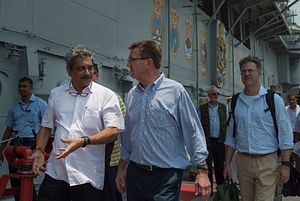Congress just sent an important message to President-elect Trump’s incoming national security team via the 2017 National Defense Authorization Act (NDAA): treat India as a “major defense partner.” While India is not a U.S. treaty ally and Indian soldiers are not fighting alongside American forces in today’s hotspots, both Democrats and Republicans recognize the national security and commercial imperatives of conducting U.S.-India defense relations at the highest level. This is the Ivory-billed Woodpecker of U.S. politics — an extremely rare, nearly extinct phenomenon — an issue of agreement among #NeverTrump national security Republicans, the Obama administration, and, by all indications, the President-elect.
Echoing legislation first introduced by Congressman George Holding (R-N.C.), the Obama White House adopted the “major defense partner” designation in June, but the NDAA goes further. It mandates actions to institutionalize the U.S. national security bureaucracy’s focus of India. They include sustaining the Pentagon’s one-of–a-kind “India Rapid Reaction Cell,” increasing military officer exchanges and requiring the Department of Defense (DoD) and State Department to assess India’s capabilities to perform military missions that are in the mutual interest of both India and the United States.
India borders both the U.S. Central Command and Pacific Command’s geographic areas of responsibilities. These combatant commands have daunting requirements, tasked to prepare for a wide range of military contingencies from war to humanitarian assistance. The assessment requirement in the NDAA is Congress’ way of telling the DoD to equip the Indian military in a manner that decreases the burdens and risks for American soldiers in these commands. This is why the assessment will be used to inform the sale of defense articles and services to India.
The intent of the law is clear. India is the only democracy with the demographic weight, economic growth and social linkages to America that can serve as the predominant security provider in the Indian Ocean Region. This is especially apparent as the growing gap between Chinese military power and that of its neighbors increases the risk of instability in Asia. This gap is provocative and dangerously so in a region that contains the world’s most important trade corridors.
The commercial imperative for the U.S.-India defense partnership is also considerable. Around 70 percent of Indian military equipment is of Russian origin and much of it is in need of replacement. American companies are well positioned to partner with Indian private and public sector manufacturers to fill the gap. These partnerships generate interoperability with U.S. forces and strengthen the U.S. defense industrial base by expanding sales in a manner that decreases procurement costs for American military forces.
Despite an unusually broad bipartisan consensus for deepening defense cooperation, this has not always translated into executive branch policies necessary to implement this vision. While there has been recent progress made under the Defense Technology and Trade Initiative, the U.S. export licensing process, end-use monitoring requirements, and the complicated intersection of government and private industry approvals required to engage in defense trade do not put American companies at a competitive advantage in India. Too often it appears easier for Indians to work with the Russians, French, and Israelis than to cooperate with Americans.
An important priority of the President-elect should be to reverse this perception. The next National Security Advisor should conduct a comprehensive review of the policies and procedures that weaken U.S. competitiveness in the Indian defense and aerospace market. For instance, if there are defense technologies that the United States has refused to sell to India on national security or counter-proliferation grounds, but which India can now purchase from other foreign suppliers, then these policies should be revised. The United States does not have the monopoly it once did in many defense technologies and our policies needs to adapt to this reality. When the United States restricts the export of defense technologies that are similar or only marginally superior to the offerings of foreign manufactures those other countries fill the vacuum. This not only deprives American industry of critical markets, but also prevents the U.S. government from the opportunity to cooperate and even shape how these weapons are employed. It’s a dangerous and self defeating approach to counter proliferation. From both a commercial and national security perspective, it is advantageous that a country like India purchase advanced defense equipment from America than from our foreign competitors.
Many problems are too contentious to solve in our politically polarized capital, but fortunately this isn’t one of them. This should be an easy win for the next President and an important win for the country.
Benjamin Schwartz is the director for defense and aerospace at the U.S.-India Business Council and previously served as director for India in the Office of the U.S. Secretary of Defense.

































